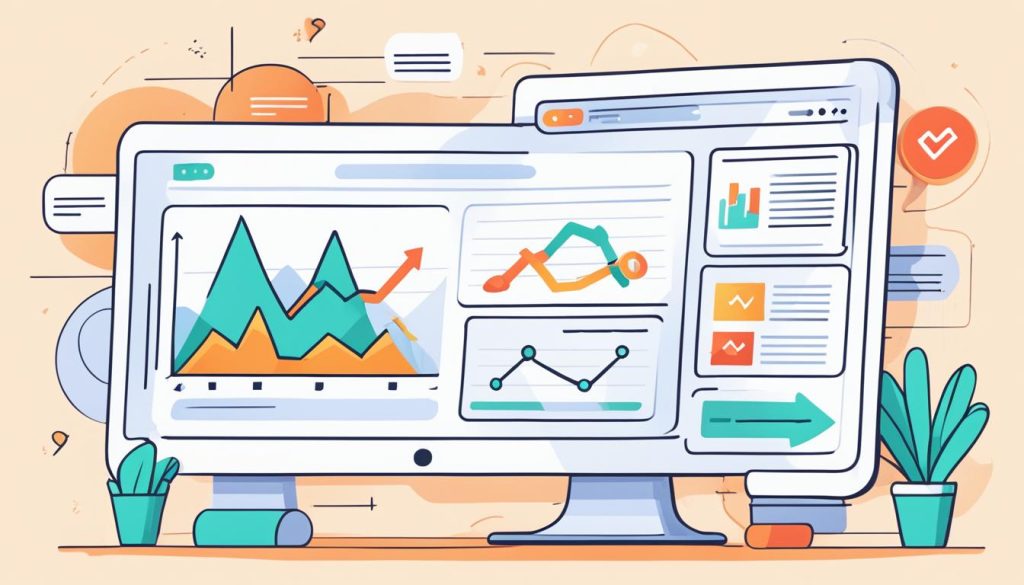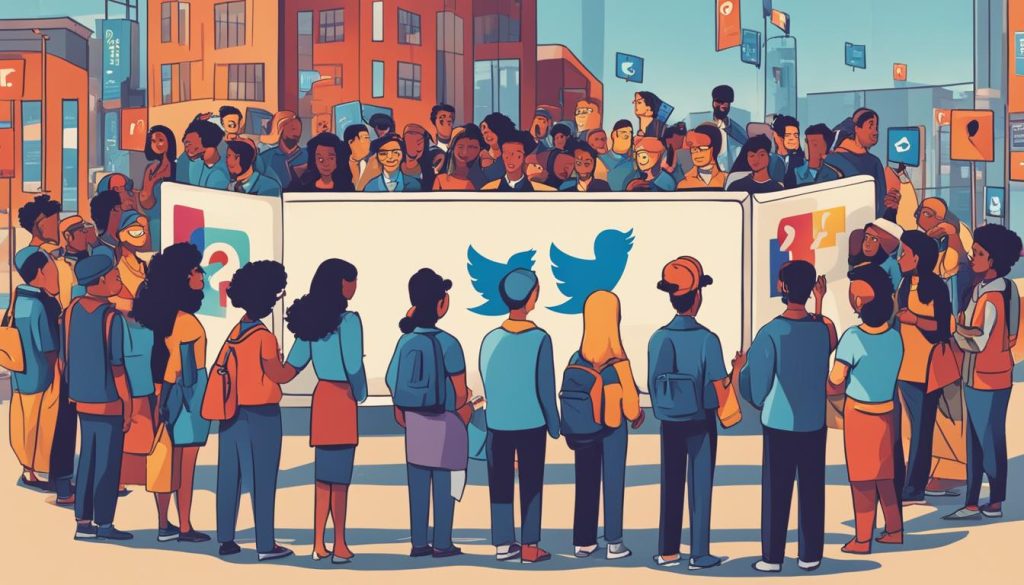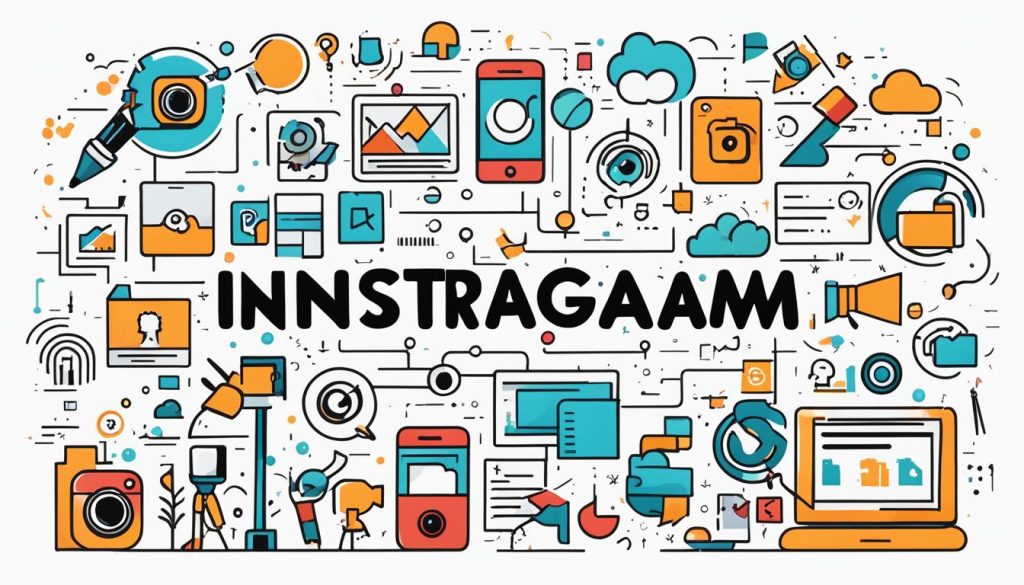In today’s competitive digital marketplace, we at Grew Studio recognise the significance of user engagement as a cornerstone of online success. However, many businesses encounter the perplexing issue of high bounce rates, where a substantial flow of visitors exit a website shortly after arriving. This phenomenon reflects untapped potential and a pivotal metric known as the bounce rate, which indicates the percentage of visitors who navigate away without exploring further. As the CEO of Grew Studio, Adam Oliver Kollar, stresses, attaining a deep understanding of this key performance indicator (KPI) and implementing strategies to reduce it could transform a passive digital audience into active participants, leading to increased brand loyalty, awareness, and, importantly, sales.
Bounce rates vary across industries; an alarming rate would lie between 70-80%, while an average falls within 50-70%, and an excellent rate would range from 30-50%. It is our mission to guide businesses through the digital landscape, helping them to achieve optimised conversion rates for enhanced customer journey experiences. We are delighted to extend an invitation for a complimentary 30-minute strategic consultation to address this critical issue.
Key Takeaways
- High bounce rates may indicate a gap in user engagement and retention strategies.
- Understanding and analyzing the causes of high bounce rates is crucial for website performance optimisation.
- Different industries present variable benchmarks for what constitutes a concerning bounce rate.
- Directly addressing bounce rates can significantly impact conversion rates without additional investment.
- Offering strategic consultation, Grew Studio is committed to enhancing visitor retention and website performance.
Understanding Bounce Rate as a Critical Performance Metric
Bounce rate emerges as a pivotal performance indicator in the digital landscape, shedding light on visitor behaviour and their interaction with your website. Acknowledging its significance within website analytics is the starting point for any traffic analysis and session analysis. Essentially, it assists in gauging the immediate relevance and engagement of your content to the users who land on your pages.
Defining Bounce Rate in the Context of Website Analytics
In our analytics tool, bounce rate is quantified as the percentage of all sessions on your site in which users have visited only a single page and triggered no requests to the analytics server beyond the initial pageview. High bounce rates may originate from a variety of aspects, ranging from content discrepancies to user experience issues. It is imperative to not only track these rates but also delve deeper to understand the underlying causes.

An effective marketing strategy employs bounce rate as a lens through which visitor behaviour can be analysed. We recognise this metric as a crucial alarm bell—when high, it alerts us to potential content or usability issues; when low, it indicates a resonance between your audience’s expectations and what you present to them.
The Importance of Bounce Rate in Digital Marketing Strategies
The profound value of bounce rate analysis lies in its direct correlation with engagement metrics. These figures not only reflect how well your landing page captures the audience’s attention but also how effectively it propels them further into your website, which is essential for successful conversion optimization. A thorough bounce rate examination should integrate seamlessly into a digital marketing strategy, aiming to convert fleeting visits into lasting engagements.
| Bounce Rate Percentage | Interpretation | Recommended Action |
|---|---|---|
| Below 30% | Excellent engagement | Monitor and maintain successful features |
| 30% – 70% | Average to fair | Analyse visitor data and improve content relevancy |
| Above 70% | Low engagement | Comprehensive review and strategic enhancements needed |
We are committed to leveraging bounce rate data to optimise our digital marketing efforts. By interpreting these performance metrics, we can implement targeted improvements, elevate user engagement, and drive our conversion optimization forward—ultimately enhancing our overall marketing strategy.
Identifying the Impact of User Experience on Bounce Rates
At Grew Studio, we understand that in the digital realm, the user experience (UX) is pivotal in determining the success of a website. An exemplary UX/UI design is not just about aesthetics; it’s about creating a seamless interaction design that guides users effortlessly from one point to another on the website. This enhances website usability and, in turn, influences visitor retention and engagement. Conversely, a poor UX can be detrimental, leading to a disconnect between the site’s offerings and user expectations, resulting in elevated bounce rates.
Interaction design — the process of crafting engaging interfaces with well-thought-out behaviours — plays a critical part in the UX journey. We observe that when users interact smoothly with a website’s functionalities and find pleasure in navigating through the content, the chances of them staying and converting are significantly higher.
| UX Component | Impact on User Behaviour | Relation to Bounce Rates |
|---|---|---|
| Site Loading Time | Immediate first impression, patience threshold | Direct correlation: slower loading increases bounce rates |
| Navigation Ease | Ability to find desired information or products | Complex navigation inflates bounce rates |
| Content Layout | Readability and scannability of information | Poor layout can frustrate users, spiking bounce rates |
| Responsive Design | Consistency across different devices and screens | Non-responsive designs push users away |
We, at Grew Studio, continuously strive to marry aesthetics with functionality to ensure that our UX/UI design not only meets but exceeds user expectations. It’s an encompassing endeavour, ranging from the visual elements to the interactive components that dictate a user’s journey on a website. Let us enhance your platform’s user experience, ensuring users do not just arrive but stay, engage, and return.
Analyzing Causes of High Bounce Rates
At Grew Studio, we understand that reducing high bounce rates is crucial for any website aiming to keep its visitors engaged. Through our analyses, we’ve identified several key areas of improvement. One such area is ensuring content relevance, as users expect to find material that aligns with their search queries and needs. Additionally, page loading speed is a critical factor; with each extra second leading to potential visitor losses.
Internal linking is another strategic element that keeps users navigating through a site, thereby lowering bounce rates. A well-structured website layout with clear and intuitive navigation positively impacts user experience, encouraging deeper engagement with website content.
| Issue | Impact on Bounce Rate | Grew Studio’s Strategy |
|---|---|---|
| Slow Page Loading Speed | Immediate drop-off of visitors | Optimization of media files and code |
| Content Not Relevant | Quick exit after landing | Aligning content with user intent and search patterns |
| Poor Internal Linking | No incentive to explore further | Crafting helpful, contextually relevant links |
| Complex Website Layout | Frustration and confusion leading to abandonment | Redesign for simplicity and usability |
Our approach places these elements at the forefront of our diagnostic process, ensuring we address the core issues that lead to unwelcomed site abandonment. Whether it’s a vibrant call-to-action, mobile responsiveness, or the aesthetic appeal of the site, each forms part of our comprehensive website improvement strategy.

We consider the multifaceted nature of user engagement and strive to create a cohesive web environment that not only draws in visitors but also compels them to stay and interact with content. It’s through this meticulous evaluation and enhancement of web properties that we can turn high bounce rates into a metric of the past.
Strategies to Enhance User Engagement and Reduce Bounce Rates
At Grew Studio, we understand that bolstering user engagement is fundamental in the crusade against high bounce rates. The journey to refine your website involves making vital adjustments that not only draw visitors in but also compel them to linger and interact with your content. In this segment, we shall uncover the stratagems vital for augmenting your website performance and bolstering your digital presence.
Optimising Page Loading Speed for Improved Retention
The exigency of page loading speed cannot be overstated when considering user retention. A website’s ability to display content promptly correlates directly with a user’s decision to stay or bounce. Through meticulous performance analysis, we’ve established that enhancement in loading times leads to tangible website improvements. We advocate for the compression of images, the minimisation of CSS and JavaScript files, and the use of browser caching techniques to perpetuate site agility.
Enhancing Content Relevance to Match Visitor Expectations
Ensuring that your content resonates with your audience’s anticipations is pivotal. Content relevance is a critical factor that underpins user interest and, by extension, engagement levels. We encourage constant revitalisation of your website’s content to maintain alignment with current trends and visitor interest. This process is informed by user feedback and session recordings, which provide invaluable insights into the preferences of your audience segments, thus facilitating tailored and compelling content.
Refining Navigation Design for an Intuitive User Journey
Effective navigation design optimises a user’s expedition through your website, engendering a seamless and intuitive exploration that naturally progresses towards the conversion funnel. By equipping your website with an intelligible and user-focused navigation structure, we ease the discovery process, reinforce interaction design, and enhance the overall customer journey. The outcome is a streamlined path that guides each visitor towards their goal with clarity and efficiency.
We cannot stress enough the centrality of these strategies in crafting a user-centric platform. To exemplify our approach, the following table delineates our optimisation tactics alongside the anticipated benefits:
| Optimisation Tactic | Objective | Anticipated Benefit |
|---|---|---|
| Minimise media file sizes | Decrease load times | Enhanced user retention |
| Update content regularly | Maintain relevancy | Increased user engagement |
| User-centric navigation | Simplify discovery process | Improved progression in conversion funnel |
In light of these strategies, we invite you to embark on a performance refinement journey with us. Together, we can diminish bounce rates and forge a user experience characterised by speed, relevance, and intuitive interaction.

The Role of Mobile Optimization in Mitigating Bounce Rates
We at Grew Studio recognise the profound impact that mobile optimization has on today’s digital landscape. With an increasing amount of web traffic originating from mobile devices, the importance of responsive, mobile-friendly UX/UI design cannot be overstated. Our ‘mobile-first’ approach prioritises the user experience for mobile users, ensuring that websites are not only accessible but also offer supreme website usability across a multitude of screen sizes.

Focusing on visitor retention, our strategies revolve around designing interfaces that provide an impeccable user experience on smartphones and tablets, without neglecting desktop users. By doing so, we help businesses reduce bounce rates and maintain a competitive edge in the market. Let’s explore some key aspects that underline the significance of mobile optimization:
- Streamlined Navigation: Simplified site navigation is crucial for mobile users who rely on touch interactions. We ensure large clickable areas and minimise the depth of menu layers.
- Responsive Design: Our design adapts to any screen size, offering a consistent experience that encourages users to stay longer and explore deeper into the site.
- Fast Loading Times: Speed is essential for mobile users. We optimise images and code for quick load times to avoid losing visitors to impatience.
- Touch-Friendly Elements: We ensure buttons and form fields are of adequate size for ‘fat fingers’ to avoid frustration and accidental clicks.
Through such targeted efforts, Grew Studio dramatically improves website usability which is a pivotal factor in enhancing visitor retention. Our commitment is to provide seamless and fast mobile experiences that align perfectly with user expectations, thus playing an integral role in the continuous effort to decrease bounce rates.
Employing A/B Testing to Evaluate Call-to-Action Effectiveness
At Grew Studio, we harness the propensity of A/B testing to drill down into the nuances of user behaviour analysis and glean engagement metrics that inform strategic enhancements to our call-to-action effectiveness. This empirical approach grants us the facility to unravel what incites users to act, and equally what may detract them from fulfilling the desired action within our conversion funnel.
Understanding the Role of A/B Testing in User Behaviour Analysis
Our approach to A/B testing is rooted in methodical experimentation. We place two variants—the ‘A’ version and the ‘B’ version—before users in a controlled environment. This side-by-side assessment meticulously measures performance metrics such as click-through rates, time spent on page, and the ultimate conversion rates. By distinguishing which variant yields superior engagement metrics, we infer actionable insights that power our marketing strategy. This disciplined scrutiny empowers us to refine user interfaces, content, and messaging.

Applying Insights from A/B Testing to Improve Conversion Funnel
Capitalising on the insights from A/B tests, we adjust and optimise each touchpoint within the conversion funnel. It allows us to fortify the path that leads from initial interest to ultimate conversion. Whether it is tweaking the text on a call-to-action button or altering the page layout, the goal is always to enhance the user’s journey towards conversion. We strive to harness these insights to produce more than just incremental changes—we aim for transformative evolution in our call-to-action effectiveness.
By integrating the successive layers of learning from successive A/B testing campaigns into our marketing strategy, Grew Studio aspires to craft a user experience that is not just visually and textually appealing, but one that is psychologically congruent with our audience’s expectations and motivations.
Leveraging Analytics for Comprehensive Traffic and User Behaviour Analysis
At our studio, the emphasis has always been on harnessing the full potential of website analytics to comprehensively interpret both traffic and user behaviour. In an age saturated with data, it is essential that we attentively decipher the patterns that emerge from within this data-rich environment, thus rendering visible the invisible threads of visitor engagement and retention.
Integrating Heatmap Analysis to Uncover Actionable Insights
Heatmap analysis stands as a robust tool, providing an intuitive, visual story of where users are most engaged on a page. By meticulously studying the vibrant patches of warmth and coolness that represent user interaction hotspots, we gain insights crucial for understanding visitor behaviour and maximising user engagement. With these data visualisations, we can pinpoint precisely the sections of a website that magnetise attention and those that repel it, shaping our strategies for enhancement of user experience.
Utilising Session Recordings and Behaviour Tracking for Deeper Understanding
In complement to heatmaps, session recordings and behaviour tracking offer an unobstructed window into the user’s journey through a website. These instruments are instrumental in identifying patterns of navigation, shining a light on what resonates with the audience and what prompts them to depart. By evaluating these recordings, we gather crucial knowledge about hesitation points that could be leading to diminished visitor retention and subsequently employ this understanding in our performance analysis for strategic refinements.
Combining heatmap analysis with the dynamic depth of session recordings ensures that our visitor retention strategies are not just reactive adjustments but proactive steps towards cultivating an environment tailored for sustained and meaningful user engagement.
Addressing Technical Factors Contributing to High Bounce Rates
At Grew Studio, we understand that underlying technical factors are often significant contributors to high bounce rates. A website’s design, its usability, and the quality of traffic it receives, all intersect to form a user’s experience; these are elements we cannot afford to overlook in our conversion optimisation efforts. Through meticulous analysis and refinement, we ensure that our website design practices not only meet but exceed industry standards, resulting in an optimised user experience that fosters engagement.
To further contextualise these aspects, let us explore how website usability can dramatically affect visitor interactions:
- Navigation: Intuitive site structure enables visitors to find what they’re looking for, increasing the likelihood of engagement rather than exit.
- Responsiveness: Good design must cater to various devices, ensuring seamless interaction whether on a desktop or a mobile device.
- Loading Times: Accelerated page load speeds are integral to keeping visitors on the site, with each second of delay increasing bounce rates.
In conjunction with website design and usability, the quality of traffic plays an equally pivotal role. Drawing in the right audience through targeted SEO practices ensures that visitors are more likely to find relevance in the content, positively influencing their on-site behaviour and likelihood to convert.
We focus on attracting visitors who are seeking what we offer, creating a harmonious match between user needs and our content. This strategic approach enhances both the quantity and the quality of our traffic, leading to more meaningful interactions and reduced bounce rates.
Executing these strategies has allowed us to create a web environment that not only attracts visitors but more importantly, retains them. We achieve this by consistently prioritising the end-user in every decision, contributing to a significant reduction in bounce rates and a substantial improvement in conversion optimisation.
Conversion Optimization: Mastering the Intersection of UX/UI Design and Marketing Strategy
At Grew Studio, we recognise the art of conversion optimization lies at the crossroads of innovative UX/UI design and a nimble marketing strategy. To truly excel in the digital arena, we must synchronise these elements to provide an engaging user journey that not only satisfies but also surpasses customer expectations.
Improving Website Layout and Internal Linking Structure
Our concerted focus on enhancing the website layout creates an intuitive environment that effortlessly guides users through content, supporting a swift, meaningful journey towards conversion. Fascinatingly, internal linking contributes to this seamless navigation, subtly steering visitors through a series of desired actions and engagements.
Adapting Marketing Strategy Based on Performance Metrics and Customer Feedback
Adaptability in our marketing strategy is paramount; we are dedicated to continuous improvement driven by concrete performance metrics and invaluable customer feedback. This approach empowers us to tailor strategies that not only increment conversion rates but also elevate engagement metrics, creating a virtuous cycle of growth and customer satisfaction.
| Performance Metric | Initial Value | Target Value | Strategy Impact |
|---|---|---|---|
| Conversion Rate | 1.5% | 3% | Refined CTA placement |
| User Session Duration | 2 min | 5 min | Enhanced content relevance |
| Page Views per Visit | 3 pages | 5 pages | Improved internal linking |
| User Feedback Positivity | 70% | 90% | Iterative design improvements |
As we navigate the intricate web of digital customer interaction, our forward-thinking tactics are carefully crafted to not only capture interest but to also forge connections that endure. This is the essence of what propels Grew Studio to the forefront of the conversion optimisation landscape.
Advanced Techniques for Segmenting Visitors and Personalizing Experiences
At Grew Studio, we firmly believe in the transformative power of visitor segmentation and personalization. These practices stand as the cornerstones of a refined digital strategy that prioritises relevant and captivating user interactions.
Through meticulous user behaviour analysis, we unearth intricate patterns and subtle nuances in our audience’s online activities. This multifaceted knowledge enables us to segment visitors into distinct groups, each characterized by their unique behaviours and preferences. Such segmentation forms the bedrock upon which we craft personalised content, thereby fostering deeper connections with our users.
Personalisation isn’t just beneficial; it’s expected. Today’s savvy visitors demand experiences that reflect their interests, challenging us to tailor our approach and deliver on these expectations with finesse and empathy.
Our continuous monitoring of engagement metrics serves as a feedback loop, ensuring that each personalisation effort we make is aligned with our visitors’ evolving interests and behaviours. By interpreting these metrics accurately, we intuitively adapt and refine our strategies, maintaining a dynamic and user-focused online presence.
We utilise various advanced techniques to achieve high-level personalisation:
- Behavioural email targeting based on user interactions
- Dynamic content presentation that aligns with visitor interests
- Recommender systems employing machine learning for individualised content discovery
- Geo-targeting to provide region-specific experiences
The synergy of these advanced techniques propels the customisation of user experiences to unprecedented heights, setting a benchmark for digital excellence in the industry.
Alignment between audience insights and content delivery is quintessential for securing our users’ loyalty and boosting our brand’s reputation. Mastering these subtleties is not merely beneficial but indispensable in the increasingly competitive digital space where user-centricity rules supreme.
Conclusion
In closing, it is essential for us at Grew Studio to acknowledge the complexity of grappling with high bounce rates. A multifaceted strategy is paramount to enhancing user interaction and ultimately, boosting conversion rates. It is our belief that through meticulous performance analysis and incremental website improvements, the elusive endeavour of diminishing bounce rates is entirely attainable.
The deployment of actionable insights gleaned from robust analytics and user feedback has been instrumental in our pursuit of optimisation. Our dedication extends beyond surface metrics; we delve deep into user experience, align content relevance with user expectations, and ensure the technical prowess of digital platforms, thus fortifying our strategic marketing endeavours.
The journey towards reduced bounce rates and enhanced engagement is ongoing. As we continue to leverage the latest tools and adopt innovative practices, our commitment remains steadfast: to refine the digital experience and deliver sustainable improvements. For Grew Studio, this is more than a mere goal—it is the cornerstone of our value proposition to our clients and their customers.
FAQ
What constitutes a high bounce rate and why is it significant?
A high bounce rate is typically characterised by 70-80 percent of website visits where a single page is viewed before a visitor leaves. This metric is significant because it can indicate a lack of engagement or dissatisfactory user experience, leading to missed opportunities for conversions and sales.
How does bounce rate impact our digital marketing strategy?
Bounce rate serves as a critical performance metric by revealing the effectiveness of our website in maintaining visitor interest. A high bounce rate may signal the need to revise our digital marketing strategies, ensuring that we are targeting the right audience with relevant content and a captivating user experience.
In what ways does user experience influence bounce rates?
User experience directly affects how long a visitor stays on a page and whether they engage further. A seamless and intuitive UX/UI design makes it easier for visitors to navigate and find value in our website, thus potentially reducing bounce rates.
Why are page loading speeds crucial for website retention?
Page loading speeds are vital because visitors typically favour websites that load quickly. A slow-loading website can lead to frustration and a higher bounce rate, as users may not wait for content to become visible.
How does content relevance reduce the likelihood of visitors bouncing?
Content relevance captivates visitors by aligning with their interests and expectations. When our website displays content that resonates with our audience, they are more likely to stay engaged, explore further, and potentially convert.
Why is mobile optimization an essential aspect of reducing bounce rates?
With an increasing number of users accessing websites via mobile devices, it’s crucial to ensure that our website provides a responsive and user-friendly experience regardless of device. Mobile optimization can prevent visitor drop-off by accommodating different screen sizes and improving usability on mobile platforms.
How does A/B testing aid in enhancing user engagement?
A/B testing allows us to experiment with different website elements to determine which versions yield the best user engagement and conversion rates. By using this data-driven approach, we can refine our call-to-action prompts, design choices, and overall marketing strategy to reduce bounce rates.
Can heatmap analysis provide actionable insights to improve our website?
Yes, heatmap analysis visually represents where users click, move, and scroll on our website. These insights enable us to identify high and low engagement areas, guiding us to make effective design and content improvements that could help in reducing bounce rates.
What technical factors should we address to mitigate high bounce rates?
Technical factors to consider include website design, load times, navigation functionality, and content layout. Ensuring that these elements are optimized can help provide a smoother user experience, reducing the likelihood of visitors leaving promptly after arrival.
How does integrating marketing strategy with UX/UI design improve conversions?
By creating a cohesive experience that aligns marketing objectives with user-centric design, we can guide visitors through the conversion funnel more effectively. This approach includes optimizing website layout, internal linking, and providing a seamless customer journey that resonates with our target audience.
What role does visitor segmentation play in personalising the user experience?
Segmenting visitors allows us to tailor content and interactions based on their unique preferences and behaviour. Personalising the user experience in this way can enhance engagement, leading to a greater chance of conversion and a lower bounce rate.





